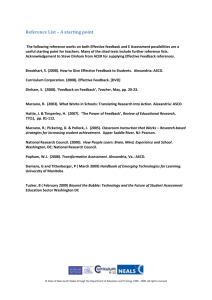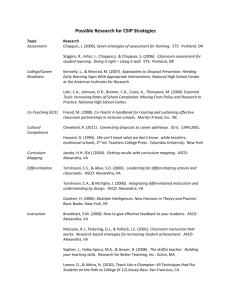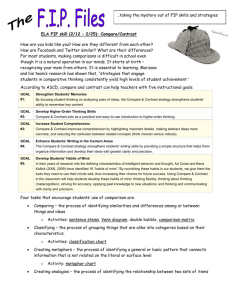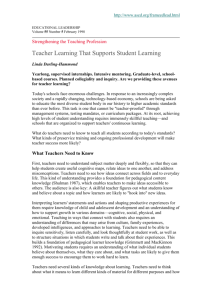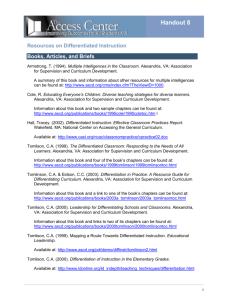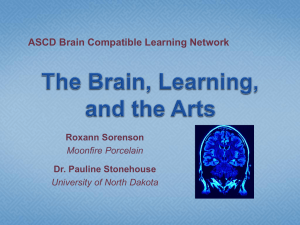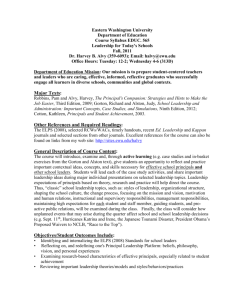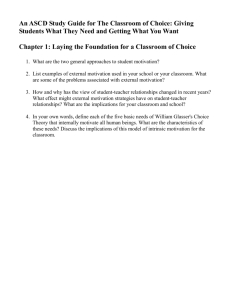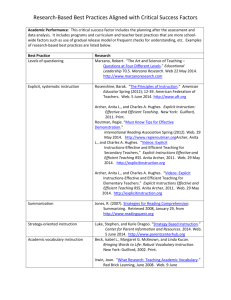Ed. Soc. 506 - Eastern Washington University
advertisement
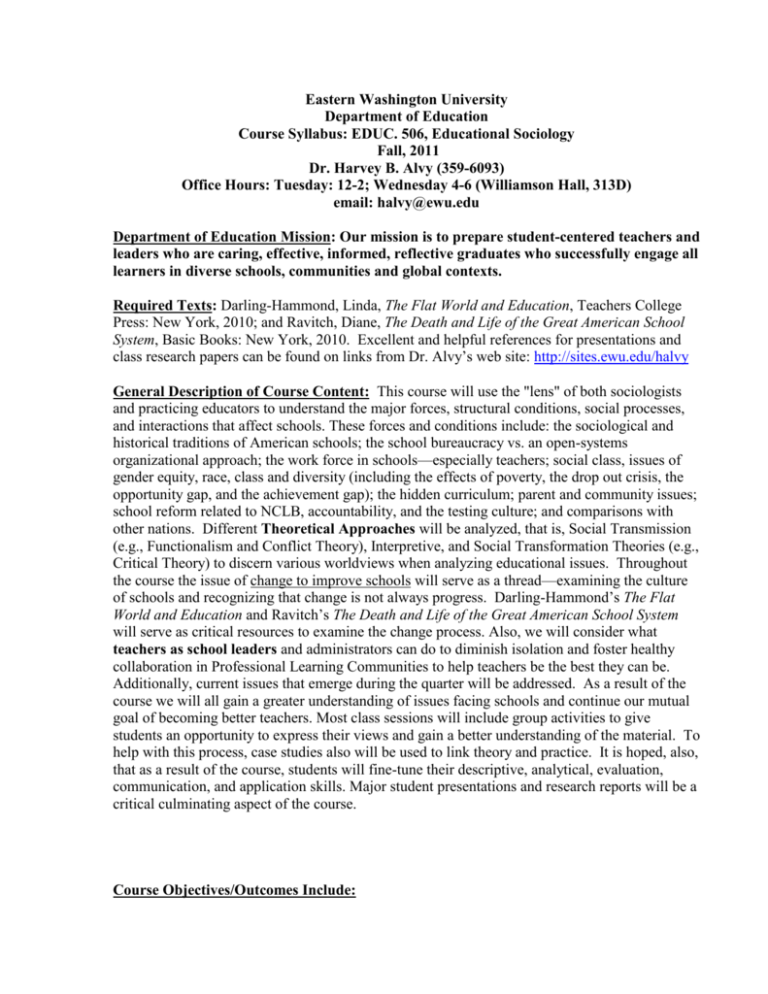
Eastern Washington University Department of Education Course Syllabus: EDUC. 506, Educational Sociology Fall, 2011 Dr. Harvey B. Alvy (359-6093) Office Hours: Tuesday: 12-2; Wednesday 4-6 (Williamson Hall, 313D) email: halvy@ewu.edu Department of Education Mission: Our mission is to prepare student-centered teachers and leaders who are caring, effective, informed, reflective graduates who successfully engage all learners in diverse schools, communities and global contexts. Required Texts: Darling-Hammond, Linda, The Flat World and Education, Teachers College Press: New York, 2010; and Ravitch, Diane, The Death and Life of the Great American School System, Basic Books: New York, 2010. Excellent and helpful references for presentations and class research papers can be found on links from Dr. Alvy’s web site: http://sites.ewu.edu/halvy General Description of Course Content: This course will use the "lens" of both sociologists and practicing educators to understand the major forces, structural conditions, social processes, and interactions that affect schools. These forces and conditions include: the sociological and historical traditions of American schools; the school bureaucracy vs. an open-systems organizational approach; the work force in schools—especially teachers; social class, issues of gender equity, race, class and diversity (including the effects of poverty, the drop out crisis, the opportunity gap, and the achievement gap); the hidden curriculum; parent and community issues; school reform related to NCLB, accountability, and the testing culture; and comparisons with other nations. Different Theoretical Approaches will be analyzed, that is, Social Transmission (e.g., Functionalism and Conflict Theory), Interpretive, and Social Transformation Theories (e.g., Critical Theory) to discern various worldviews when analyzing educational issues. Throughout the course the issue of change to improve schools will serve as a thread—examining the culture of schools and recognizing that change is not always progress. Darling-Hammond’s The Flat World and Education and Ravitch’s The Death and Life of the Great American School System will serve as critical resources to examine the change process. Also, we will consider what teachers as school leaders and administrators can do to diminish isolation and foster healthy collaboration in Professional Learning Communities to help teachers be the best they can be. Additionally, current issues that emerge during the quarter will be addressed. As a result of the course we will all gain a greater understanding of issues facing schools and continue our mutual goal of becoming better teachers. Most class sessions will include group activities to give students an opportunity to express their views and gain a better understanding of the material. To help with this process, case studies also will be used to link theory and practice. It is hoped, also, that as a result of the course, students will fine-tune their descriptive, analytical, evaluation, communication, and application skills. Major student presentations and research reports will be a critical culminating aspect of the course. Course Objectives/Outcomes Include: • • • • • • • • • • • Considering sociological theories and historical constraints to gain a broad perspective of educational issues (i.e., Functionalism, Conflict Theory, Interpretive Theories, and Critical Theory ) Reviewing the Bureaucracy and Open-Systems Approach to school organizations as a framework for understanding key concepts Examining the American value system as it relates to schools Considering Darling-Hammond’s observations and reflections related to comparing U. S. school to other nations, the achievement and opportunity gap, the effects of poverty, funding of schools, the testing culture, and reform efforts related to the improvement of teacher preparation and general education policy. Considering Ravitch’s observations and reflections related to school change and standards, testing, accountability, choice, teacher work and NCLB. Examining the workforce in schools, focusing on the lives of teachers, isolation, and the importance of developing Professional Learning Communities. Discussing the unique educational needs of all students, regardless of background. Considering the influence of the “hidden curriculum” on students, especially related to various roles and expectations about race, gender, and class. Understanding the effects of poverty on student learning and the importance of closing the achievement gap, addressing the opportunity gap, and reducing the drop out rate. Identifying socioeconomic factors and social class structures of American society. Examining Weber’s theory of social class structure and the importance of education. Reviewing compensatory educational programs. (e.g., Head Start, aspects of NCLB) Examining key legal decisions and legislation, especially related to equality of educational opportunity, including desegregation programs, and gender equity. Using case studies to foster discussion and connect theory to practice. Addressing current issues that develop during the quarter. Tentative Course Outline September 22, 2011 Orientation to class: ice-breaker, discuss syllabus and student expectations. Review Social Transmission, Interpretive and Social Transformation Theories, to help students understand school dynamics. Assignments for September 29th: The Flat World and Education, Chapter 1; The Death and Life of the Great American School System, Chapters 1 & 6; begin journal reflections. September 29, 2011 Major Sociological Theories: Continue discussion from Sept. 22nd on major sociological theories that affect schools. The Bureaucratic Organization of Schools and Moving Toward an Open System Model: Examining the loose coupling of schools, the bureaucracy, scientific management, centralization, decentralization, and the small schools movement (personalization). A question that should always be in the forefront of our thinking is: How does the organization of schools affect teaching, learning, curriculum, assessment, and leadership? 2 Examining Darling-Hammond and Ravitch’s world-views on the critical issues facing education in the United States. Assignments for October 6: The Flat World and Education, Chapter 5; The Death and Life of the Great American School System, Chapters 3 & 4. October 6, 2011 Students as the Core of a School: Are Schools Serving Our Youth Successfully? Issues, such as, the drop out crisis, informal cultural influences, and the power of the environment, will be discussed. Important questions are: Do youth have a distinct culture? Are they a “Tribe Apart” as described by Patricia Hersch? Continuing to Examine School Organizations by Observing Reform Efforts in Various States Analyzed by Darling-Hammond and Ravitch. Assignment for October 13: The Flat World and Education, Chapters 6 & 7; The Death and Life of the Great American School System, Chapter 9; October 13, 2011 The Culture of Schools and the Roles of Professions and Support Staff: Examining the daily lives of teachers, administrators, counselors, and staff. The history of the workforce, nature of work, rewards, and burnout will be discussed. What Can We Learning from Darling-Hammond’s Analysis Comparing Teacher Work in the U. S. with Other Nations? How Does Ravitch’s Nostalgic View of Mrs. Ratliff Align with Teacher Incentives Today? Assignment for October 20: The Flat World and Education, Chapter 3; The Death and Life of the Great American School System, Chapters 2 & 8. Submit one-page research presentation proposal with your partner(s). October 20, 2011 The Process of Stratification, Testing Effects, Social Class and Schools: Why is social class such a major issue regarding inequality and a source of differences in achievement? A discussion of the influence of key sociologists concerned with social class and class bias (Weber and Bourdieu) will take place. We will also review teacher expectations related to ability grouping and testing (the influence of tests); school choice will, in addition, be addressed. What insights, new ideas, and concerns emerge for you based on Darling-Hammond and Ravitch’s analysis of standards, testing and accountability? Assignment for October 27th: The Flat World and Education, Chapters 2 & 4. Collect Reflective Journals. October 27, 2011 3 Race, Class, Gender and Ethnic Minorities: Equality of Educational Opportunity: Since the 1950's schools have played a leading role to assist underserved minorities, often through federal laws and legislation (e.g., desegregation, integration, NCLB), regarding compensatory education, closing the achievement gap, and equal access regarding the opportunity gap. Hard research (e.g. the work of Coleman) and anecdotal evidence presents a mixed review of how far we have come regarding excellence and equity for all. Concerning gender, issues addressed will include, critical federal legislation relating to equal opportunity, applying the legislation beyond sports, gender differences in achievement and expectations, the critical role of classroom teachers, and the impact of curriculum and instructional decisions, especially relating to "messages" implicit in schools. The role of families and communities must also be considered. At the end of the day, we must ask: Have schools succeeded to meet the needs of all students? Clearly, Darling-Hammond’s Emphasis on the Opportunity Gap, and Funding Inequity in the United States, Challenges Our Ability to Be Globally Competitive. What Needs to Change Based on Her Assessment? Assignments for November 3 and November 10: The Flat World and Education, Chapters 8 & 9; The Death and Life of the Great American School System, Chapters 7 & 11. November 3, 2011 The Hidden Curriculum: An examination of the hidden curriculum reviews what really happens in schools beyond the explicit expectations of “official” policies, curriculum, role behaviors, and published data. That is, the everyday climate and culture (“what is right and rude?”) that influences student, teacher, and administrative behaviors and student results needs to be honestly assessed. Educational Movements and Reform I: A brief overview of important trends and movements in education will be reviewed, guided by the question: How do we discern changes of substance, from educational fads? As You Assess Darling-Hammond and Ravitch’s Examination of Issues, and Reform Recommendations, Consider: Are Their Suggestions Realistic? Do Their Ideas Have a Chance To Succeed? What Are the Barriers and Pathways to Success? November 10, 2011 Educational Movements and Reform II: Continue our analysis of important trends and movements in education guided by the question: How do we discern changes of substance from educational fads? Preparing The Research Presentations: Half of the evening class will be set aside to work with your partner(s) on your research presentations. The Take Home Final will be distributed and reviewed. The Take Home Final must be completed by Tuesday, December 6, 2011. Assignment for November 17: Selected Groups Complete Research Presentations. 4 November 17, 2011 Group Research Presentations Assignment for December 1: Selected Groups Complete Research Presentations. All Students Complete Research Reports. (Hand in Reflective Journals and Take Home Exams by December 6, 2011.) November 24, 2011—Happy Thanksgiving! December 1, 2011 Group Research Presentations Assignment for December 6: Hand in completed Reflective Journals and Take Home Exams by December 6th. (If you would prefer, you have the option of handing in the Journals on December 1.) December 6, 2011—Complete Take Home Exam Evaluation/ Assessment Procedures Note: regarding the rationale behind the forms of assessment: The quality/success of the course will depend a great deal on the individual and group contributions that you make. Educators should be successful communicators, decision makers, listeners, problem solvers and reflective practitioners. We will work on these skills together. Final grades will be based on the following four areas: 1. Constructive class participation, keeping up with texts, and other handouts. This includes presenting your insights, new perspectives, concerns, and “ahas” each evening, and positively interacting with colleagues individually and in groups, thus, attendance is critical. 20% (If excessive absences occur I will use my discretion to penalize a student’s grade more than 20% because “real time” classroom interactions/activities cannot be “duplicated.”) 2. Reflective Journal on issues raised relating to the texts, our discussions, and your observations in and out of class. Students should write two journal entries “every” week, each entry approximately one page. Thus, each appropriate week there should be one entry critiquing and briefly summarizing an assigned chapter from The Flat World and Education, or The Death and Life of the Great American School System. Feel free to criticize constructively, the authors' comments—and provide your opinions on issues that “caught your interest” in the chapters. Consider: Which parts of the readings “pushed your buttons” or resonated with you? Basically, I am asking: What do you think of the authors’ ideas? If you do quote the authors, keep the quotes to a minimum, I am interested in your voice—what do you have to say? The other reflection in the journal each week, (thus, the second entry) may be on a topic discussed in class or outside of class. For example, you may “get in the habit” of writing your second journal reflection on our class interaction each week and sharing your opinions on important issues from the discussions. Additional topics for the second entry may relate to your teaching experience, your specific classroom or school, interaction at work, a media or community issue, or other 5 educational issues that have sociological dimensions. Each journal entry should be approximately one, word-processed page—synthesize ideas, write your points cogently. Date each of your journal entries. Share insights, new perspectives, concerns, and “ahas.” As noted in the above course outline, the journal will be collected two times during the quarter, October 27th, (8 entries) and December 6th (you have the option of handing in the second entries by December 1—include 4 additional new entries). 20% 3. Group Educational Sociology Presentations and Research Papers (Presentations 20%; Research Papers Graded Separately 20%) Groups of students will make class presentations, and write research papers on a topic related to the course. The “highlights” of the topic will be addressed during the class presentations on the evenings of November 17th and December 1st. The research papers should address critical, issues/ideas relating to the general topic. The objectives of the course, weekly topics, and the two texts can serve as "starting points" for ideas for your research topic. Concerning your topic, students must address the following question: What are the implications of my topic for schools? A sociological dimension should emerge from the topic or serve to stimulate the initial idea. Thus issues relating to social theory, class, race, gender, teaching, assessment, the organizational structure of schools, school cultures, comparisons with other nations, educational reform, equity, the achievement gap, the opportunity gap, the drop out crisis, student health/nutrition issues, school change, compensatory education, NCLB, President Obama’s educational initiatives, teacher roles, teacher isolation, accountability, choice, standards, testing, or the hidden curriculum may stimulate your interest in a topic. (Often ideas are sparked by reviewing the index of a class text, e.g., Darling-Hammond and/or Ravitch.) The topic might be a contemporary issue or a perennial problem affecting schools. SELECT A TOPIC THAT IS IMPORTANT TO YOU AND YOUR PARTNER--SELECT A PASSION! Consider the “80%--20% Rule” when deciding on a topic—that is, make sure at least 80% of the information on the topic is new for you and other group members as you build on 20% of familiar ideas. Stretch yourself! Present a one-page description, developed by all group members, to Harvey for topic approval no later than week FIVE of the class (October 20th). The final product will include the following: a) a 30 minute class presentation—please rehearse your group presentation to make sure it does not exceed 30 minutes. Again, the presentation should include topic highlights and implications for schools (often, 3-5 key points) to keep the audience interested; details should be saved for the “fact sheet” and the research paper. Moreover, the presentation should include important insights/ “ahas” or concerns that you gained from the research, significant enough to share with the class! A MAJOR PRESENTATION DOES NOT INCLUDE MINOR DETAILS. Try to have a good grasp of your material so you do not have to read “word for word” from your notes. Appropriate visual aids for the presentation, and handouts (for classmates) must be used to emphasize essential points. b) a one-page "Key Facts Sheet" on the presentation topic to be distributed to classmates immediately before your presentation. This fact sheet must be an original document, organized and written by the presenters to be used as a guide (with idea highlights) for the presentation. Thus, it is part of the oral presentation. The fact sheet should “stand alone” as an information source. It should not be a pre-fabricated handout. However, you may attach pre-fabricated handouts to your original fact sheet. 6 c) an 8 page research paper written separately by each partner, with a reasonable font size (Times, 12), and including: 1) an introduction, briefly reviewing the topic and organizational plan for your paper, 2) the main body, 3) conclusion (with insights/personal “ahas” or concerns). Use headings and subheadings to organize different aspects of the paper. (Note: the report headings and subheadings, function as a logical organizing outline, and hierarchy of heading importance.) Beyond the 8 pages, the paper must include a separate title page and separate works cited page (include at least five references that you used in the paper beyond the course texts—books, journals, Internet resources). See http://research.ewu.edu/education Use quotes sparingly—that is, when the author states a point so effectively that you “must” use his/her exact words. Use APA style (6thedition) in your narrative, and for the reference page. The report should be double-spaced, with a reasonable sized font. Keep your paper cogent and proofread it carefully. Again, presentations will be made on the evenings of November 17th and December 1st and all Research Reports are due on December 1st. Total of 40% 4. Take Home Examination completed by Tuesday, December 6, 2011 20% Selected Bibliography for Educational Sociology Alvy, Harvey, and Robbins, Pam (2010). Learning from Lincoln: leadership practices for school success. Alexandria, Virginia: ASCD. Alvy. H. (June, 2005). Preventing the loss of wisdom in our schools. Kappan, Vol. 86, No. 10. Alvy H. & Robbins, P. (May, 2005). Growing into leadership. Educational Leadership. Vol. 62, No. 8. Apple, M. W. (1993). Official knowledge: democratic education in a conservative age. New York: Routledge & Kegan Paul. Banks, J. A., & McGee Banks, C. A. (Eds.) . (1993). Multicultural education: Issues and perspectives (2nd ed.) Boston: Allyn & Bacon. Benham Tye, Barbara. (2000). Hard truths. New York: Teachers College Press. Bransford, John, Brown, Ann & Cocking, Rodney, editors. (2000). How people learn; Brain, mind, experience, and school. Washington, D. C.: National Academy Press. Breaking ranks II: changing an American institution (2004). Reston, VA: The National Association of Secondary School Principals. Bryk, Anthony & Schneider, Barbara. (2002). Trust in schools. New York: Russell Sage Foundation. Danielson, C. (2007, 2nd Edition). Enhancing professional practice: a framework for teaching. Alexandria, VA: ASCD. Deal, T., & Peterson, K. (2009). Shaping school culture. San Francisco: Jossey-Bass. 7 DuFour, R., Eaker, R. & DuFour B. (2005). On common ground. Bloomington, Indiana: NES. DuFour, Rick & Eaker, Robert. (1998). Professional learning communities at work. Bloomington, Indiana: National Ed. Services. Evans, Robert. (1996). The human side of school change. San Francisco, CA.: Josey-Bass. Freire, P. (1970). Pedagogy of the oppressed. New York: Continuum. Fullan, M. (2008). What’s worth fighting for in the principalship. (2nd edition). New York: Teachers College Press. Fullan, Michael. (2007). The new meaning of educational change. (4th Edition). New York: Teachers College Press. Giroux, H. (1988). Teachers as intellectuals: toward a critical pedagogy of learning. Mass.: Bergin and Garvey. Hattie, J. (2009). Visible learning: a synthesis of over 800 meta-analyses relating to achievement London: Routledge. Hersch, Patricia (1998). A tribe apart: a journey into the heart of American adolescence. New York: Fawcett Columbine, The Ballantine Publishing Group. Hirsch, E. D. (1987). Cultural literacy. Boston: Houghton Mifflin. Hord, Shirley, & Rutherford, William, & Huling-Austin, Leslie, & Hall, Gene (1987). Taking charge of change. Virginia: ASCD. Jackson, Philip. (1968). Life in classrooms. New York: Holt, Rinehart & Winston. Kafele, B. (2009). Motivating black males to achieve in school and life. Alexandria, VA: ASCD. Kahlenberg, Richard. (2007). Tough Liberal: Albert Shanker and the battles over schools, unions, race, and democracy. New York: Columbia University Press. Kendall, Frances. (2006). Understanding white privilege. New York: Routledge. Kozol, J. (2005). The shame of the nation. New York: Crown. Kozol, J. (1991). Savage inequalities: children in America's schools. New York: Crown. Lortie, Dan (1975). School teacher: a sociological study. Chicago: University of Chicago Press. Marzano, R. (2009). Setting the record straight on “high-yield” strategies. Phi Delta Kappan. 91 (1). Marzano, R. (2007). The art and science of teaching. Alexandria, VA: ASCD. Marzano, R. (2003). What works in schools. Alexandria, VA: ASCD. Marzano, R., Pickering, D. & Pollock, J. (2001). Classroom instruction that works. Alexandra, VA: ASCD. 8 Marzano, R., Waters, T., & McNulty, B. A. (2005). School leadership that works: from research to results. Alexandria, VA: ASCD. McCourt, Frank. (2005). Teacher man. New York. Scribner. Ravitch, Diane (2000). Left Back: a century of failed school reforms. New York: Simon and Schuster. Robbins, P., & Alvy, H. (2004). The new principal’s fieldbook: strategies for success. Alexandria, VA: ASCD. Robbins, P., & Alvy, H. (2009). The principal's companion (3rd edition). Thousand Oaks, California: Corwin Press. Rothstein-Fisch, C., & Trumbull, E. (2008). Managing diverse classrooms. Alexandria, VA: ASCD. Palmer, P. (1998). The courage to teach. San Francisco: Jossey-Bass. Pipher, Mary. (1994). Reviving Ophelia: saving the selves of adolescent girls. New York: Ballantine Books. Pollack, William. (1998). Real boys: rescuing our sons from the myths of boyhood. New York: Owl Books. Ravitch, Diane. (2001). Left back: a century of failed school reforms. New York: Simon and Schuster. Sarason, Seymour, (1990). The predictable failure of educational reform. San Francisco: Jossey-Bass. Schlechty, Phil (2001). Shaking up the schoolhouse. San Francisco: Jossey-Bass. Schmoker, M. (2011). Focus: elevating the essentials to radically improve student learning. VA: ASCD. Sizer, Ted. (1984). Horace's compromise: the dilemma of the American high school. Boston: Houghton Mifflin. Spring, Joel. (2008) The American school: From the Puritans to No Child Left Behind, 7th Edition. Boston: McGraw-Hill. Tomlinson, C. A., and McTighe, J. (2006). Integrating differentiated instruction with understanding by design. Alexandria, VA: ASCD. Weick, K. (1976). Educational organizations as loosely coupled systems. Administrative Science Quarterly, 21, 1-19. Zemelman, D., & Hyde, A. (2005). Best practice: today’s standards for teaching and learning in America’s schools. Portsmouth, N. H.: Heinemann. Zhao. Y. (2009). Catching up or leading the way. Alexandria. VA: ASCD. Note: Educational Leadership, Phi Delta Kappan, Sociology of Education Journal, and, Educational Researcher and their corresponding organizations (e.g., ASCD, AERA, PDK), are excellent sources 9 for articles related to the Sociology of Education. Almost all of these organizations have excellent websites. Education Week is an excellent contemporary source, and like “Education World,” has an excellent website. Important EWU Guidelines and Regulations I. Equality Opportunity Statement: No person shall, on the basis of age, race, religion, color, gender, sexual orientation, gender identity, national origin, or disability, be excluded from participation in, or be denied the benefits of, or be subjected to discrimination under any program or activity of Eastern Washington University. II. Affirmative Action Statement: Eastern Washington University adheres to affirmative action policies to promote diversity and equal opportunity for all faculty and students. III. Americans with Disabilities Act Statement: Eastern Washington University is committed to providing support for students with disabilities. If you are a student with physical, learning, emotional, or psychological disabilities needing an accommodation, you are encouraged to visit Disability Support Services (DSS), TAW 124, or call (509) 359-6871 and speak with the staff. 10
